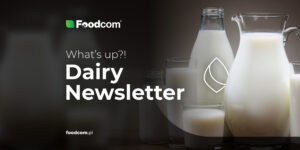- Skimmed milk powder (SMP) and butter prices are stable, but upward pressure on prices in Q1 2024 is increasing.
- Oversupply in the cheese market is pushing prices down, although demand for Mozzarella and Cagliata has increased.
- Cream is achieving high prices and selling this product is becoming more profitable than processing into butter.
- The market for whey powder and WPC 80% and WPI 90% is stable, but growing interest could boost prices in early 2024.
Welcome to Partners!
Welcome back to our newsletter!
The dairy market is showing mixed trends as we approach 2024. While prices for skimmed milk powder (SMP) and butter remain relatively stable, limited supply and strong demand in Q1 could push prices higher. Cheese prices continue to fall due to oversupply, although a slight increase in demand for Mozzarella and Cagliata has been observed. In addition, the whey protein market is stable, but increasing demand in Q1 could put upward pressure on prices for products such as WPC 80% and WPI 90%.
Let’s see what else has happened recently in the dairy market!
Milk powder
Prices for skimmed milk powder (SMP) used as feed increased to 2475 EUR/MT in the first quarter of 2024, a slight increase compared to previous values. The market is relatively tight, implying a limited number of transactions, and potential availability issues could influence additional price fluctuations, especially if demand increases or raw material supply difficulties arise. Although prices remained stable in the previous week, demand for Q1 2024 is increasing, indicating potential upward pressure on prices in the near future as buyers prepare for tougher market conditions.
For food SMP, older batches are available at price 2400 EUR/MT, while fresh produce sells at 2450-2500 EUR/MT (FCA). Despite market constraints, the slight increase in prices is due to continued demand in the food industry, where SMP is used in baked goods, desserts and beverages, among others.
Cheese
The cheese market continues to feel the pressure of oversupply, leading to price reductions. Gouda has fallen to 4600 EUR/MT, with even lower rates in some Western European markets. Mozzarella prices have fallen over the past two weeks, but there was a slight increase in demand last week. Cagliata prices have also fallen slightly, although buyer interest remains strong. Cheddar curd is approaching 4900 EUR/MT as producers offer discounts to clear excess stocks. Despite the overall downward trend, limited supply and reduced cheese production in Europe may limit further price falls.
Fats
Butter prices at the start of Q1 2024 range between 6850 and 6950 EUR/MT, with butter made from fresh cream reaching as high as 8250 EUR/MT. German butter in 10kg packs is selling above 8000 EUR/MT (FCA), indicating continued strength in the premium segment. Many buyers are looking for butter at 7400-7450 EUR/MT on the spot market, but producers are choosing to sell cream due to higher demand and better profitability compared to butter production. The butter market remains under pressure and future price movements depend on demand and raw material availability.
Anhydrous milk fat (AMF) has experienced price declines and fluctuations over the past two weeks. However, prices have stabilised this week. Although there were concerns about further declines, the market has stabilised and any significant price correction is not expected until after the festive period, possibly early in the new year. Market participants are keeping a close eye on demand, but for the time being the situation seems stable after the recent fluctuations.
Liquids
Current prices for Cream range from 9800 EUR/MT to 9950 EUR/MT, FCA, which translates into a butter price of around 8250 EUR/MT. Cream is a key raw material and its price has a direct impact on production costs and the final price of butter. Given the current market dynamics, many producers find it more profitable to sell cream than to process it into butter, as demand for cream remains high. This trend highlights the strong market for cream compared to butter in the current environment.
Skimmed Milk Concentrate (SMC) prices continued to fall, currently fluctuating between 2200 and 2250 EUR/MT, FCA Germany, with reports of some deals at 2300EUR/MT. The decline may be due to increased availability of the product or reduced demand compared to other dairy products.
Milk prices continued to rise and payments to farmers continued to increase. Given the current spot prices and payouts to farmers, there is currently no room for price reductions. Prices could only fall if there is a significant increase in milk supply or a decrease in demand, but neither of these scenarios is expected in the near future.
Whey powder
Sweet whey powder (SWP) prices have been revised upwards, with forecasts for the first quarter of 2024 indicating a level of 900 EUR/MT. Whey powder, a by-product of cheese production, is gaining in value due to increasing demand for dairy protein and its derivatives. The price increase can also be attributed to growing demand for alternative sources of protein in animal feed. Compared to the previous week, prices remain stable, reflecting continued pressure from market demand. The market for WPC 80% and WPI 90% is also stable, although we are seeing increased interest in Q1 2024. This increasing demand may result in upward pressure on prices in the new year.
What else?
South America
Ecuador is gearing up to export high-protein milk to China, an ambitious move aimed at capitalizing on growing demand in the Chinese market. While this development signals progress in Ecuador’s dairy export ambitions, the country still grapples with low domestic milk consumption. The government and producers hope that entering the Chinese market will provide a significant boost to the sector’s growth and international presence.
Global
Global destruction of nature has reached alarming levels, with over a quarter of species—around 45,300—now threatened with extinction, according to the IUCN. Deforestation remains a critical issue, with 45% more land cleared than needed to meet the global goal of halting deforestation by 2030, despite pledges from over 100 countries. Overfishing and coral bleaching are also destabilizing marine ecosystems, with 38% of fish stocks being overfished and mass coral bleaching occurring due to rising sea temperatures. Agriculture drives 90% of tropical deforestation, while $44 trillion—half of the global economy—relies on nature’s resources and services. Failure to halt ecosystem collapse could cost the world economy $2.7 trillion annually by 2030.
![Butter and SMP markets under pressure, but will cheese prices hold up? [241st Edition of the DAIRY Newsletter] Butter and SMP markets under pressure, but will cheese prices hold up? [241st Edition of the DAIRY Newsletter]](https://foodcom.pl/wp-content/uploads/2023/08/Foodcom_SA_Whats_up_Newsletter_Dairy-1520x760.jpg)






